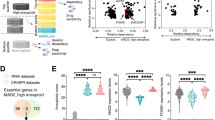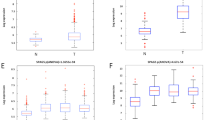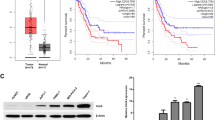Abstract
The mitotic arrest deficient 2 (MAD2) is suggested to play a key role in a functional mitotic checkpoint because of its inhibitory effect on anaphase-promoting complex/cyclosome (APC/C) during mitosis. The binding of MAD2 to mitotic checkpoint regulators MAD1 and Cdc20 is thought to be crucial for its function and loss of which leads to functional inactivation of the MAD2 protein. However, little is known about the biological significance of this MAD2 mutant in human cells. In this study, we stably transfected a C-terminal-deleted MAD2 gene (MAD2ΔC) into a human prostate epithelial cell line, Hpr-1 and studied its effect on chromosomal instability, cell proliferation, mitotic checkpoint control and soft agar colony-forming ability. We found that MAD2ΔC was able to induce aneuploidy through promoting chromosomal duplication, which was a result of an impaired mitotic checkpoint and cytokinesis, suggesting a crucial role of MAD2-mediated mitotic checkpoint in chromosome stability in human cells. In addition, the MAD2ΔC-transfected cells displayed anchorage-independent growth in soft agar after challenged by 7,12-dimethylbenz[A]anthracene (DMBA), demonstrating a cancer-promoting effect of a defective mitotic checkpoint in human cells. Furthermore, the DMBA-induced transformation was accompanied by a complete loss of DNA damage-induced p53 response and activation of the MAPK pathway in MAD2ΔC cells. These results indicate that a defective mitotic checkpoint alone is not a direct cause of tumorigenesis, but it may predispose human cells to carcinogen-induced malignant transformation. The evidence presented here provides a link between MAD2 inactivation and malignant transformation of epithelial cells.
This is a preview of subscription content, access via your institution
Access options
Subscribe to this journal
Receive 50 print issues and online access
$259.00 per year
only $5.18 per issue
Buy this article
- Purchase on Springer Link
- Instant access to full article PDF
Prices may be subject to local taxes which are calculated during checkout





Similar content being viewed by others
References
Babu JR, Jeganathan KB, Baker DJ, Wu X, Kang-Decker N, van Deursen JM . (2003). Rae1 is an essential mitotic checkpoint regulator that cooperates with Bub3 to prevent chromosome missegregation. J Cell Biol 160: 341–353.
Baker DJ, Jeganathan KB, Cameron JD, Thompson M, Juneja S, Kopecka A et al. (2004). BubR1 insufficiency causes early onset of aging-associated phenotypes and infertility in mice. Nat Genet 36: 744–749.
Bernardino J, Bourgeois CA, Muleris M, Dutrillaux AM, Malfoy B, Dutrillaux B . (1997). Characterization of chromosome changes in two human prostatic carcinoma cell lines (PC-3 and DU145) using chromosome painting and comparative genomic hybridization. Cancer Genet Cytogenet 96: 123–128.
Burds AA, Lutum AS, Sorger PK . (2005). Generating chromosome instability through the simultaneous deletion of Mad2 and p53. Proc Natl Acad Sci USA 102: 11296–11301.
Butz K, Shahabeddin L, Geisen C, Spitkovsky D, Ullmann A, Hoppe-Seyler F . (1995). Functional p53 protein in human papillomavirus-positive cancer cells. Oncogene 10: 927–936.
Cheung HW, Jin DY, Ling MT, Wong YC, Wang Q, Tsao SW et al. (2005). Mitotic arrest deficient 2 expression induces chemosensitization to a DNA-damaging agent, cisplatin, in nasopharyngeal carcinoma cells. Cancer Res 65: 1450–1458.
Cho ES, Chang J, Chung KY, Shin DH, Kim YS, Kim SK et al. (2002). Identification of tumor suppressor loci on the long arm of chromosome 4 in primary small cell lung cancers. Yonsei Med J 43: 145–151.
Choo CK, Ling MT, Chan KW, Tsao SW, Zheng Z, Zhang D et al. (1999). Immortalization of human prostate epithelial cells by HPV 16 E6/E7 open reading frames. Prostate 40: 150–158.
Dai W, Wang Q, Liu T, Swamy M, Fang Y, Xie S et al. (2004). Slippage of mitotic arrest and enhanced tumor development in mice with BubR1 haploinsufficiency. Cancer Res 64: 440–445.
De AA, Pearson CG, Cimini D, Canman JC, Sala V, Nezi L et al. (2005). The Mad1/Mad2 complex as a template for Mad2 activation in the spindle assembly checkpoint. Curr Biol 15: 214–225.
Deliveliotis C, Skolarikos A, Karayannis A, Tzelepis V, Trakas N, Alargof E et al. (2003). The prognostic value of p53 and DNA ploidy following radical prostatectomy. World J Urol 21: 171–176.
Deng W, Tsao SW, Guan XY, Lucas JN, Cheung AL . (2003). Role of short telomeres in inducing preferential chromosomal aberrations in human ovarian surface epithelial cells: A combined telomere quantitative fluorescence in situ hybridization and whole-chromosome painting study. Genes Chromosomes Cancer 37: 92–97.
Deng W, Tsao SW, Guan XY, Lucas JN, Si HX, Leung CS et al. (2004). Distinct profiles of critically short telomeres are a key determinant of different chromosome aberrations in immortalized human cells: whole-genome evidence from multiple cell lines. Oncogene 23: 9090–9101.
Di CJ, Marcy M, Vasko V, Sebag F, Fakhry N, Wynford-Thomas D et al. (2006). Molecular genetic study comparing follicular variant versus classic papillary thyroid carcinomas: association of N-ras mutation in codon 61 with follicular variant. Hum Pathol 37: 824–830.
Dobles M, Liberal V, Scott ML, Benezra R, Sorger PK . (2000). Chromosome missegregation and apoptosis in mice lacking the mitotic checkpoint protein Mad2. Cell 101: 635–645.
Dohner H, Bloomfield CD, Frizzera G, Frestedt J, Arthur DC . (1992). Recurring chromosome abnormalities in Hodgkin's disease. Genes Chromosomes Cancer 5: 392–398.
Eid MA, Kumar MV, Iczkowski KA, Bostwick DG, Tindall DJ . (1998). Expression of early growth response genes in human prostate cancer. Cancer Res 58: 2461–2468.
Fang G . (2002). Checkpoint protein BubR1 acts synergistically with Mad2 to inhibit anaphase-promoting complex. Mol Biol Cell 13: 755–766.
Fujiwara T, Bandi M, Nitta M, Ivanova EV, Bronson RT, Pellman D . (2005). Cytokinesis failure generating tetraploids promotes tumorigenesis in p53-null cells. Nature 437: 1043–1047.
Fung MK, Cheung HW, Ling MT, Cheung AL, Wong YC, Wang X . (2006). Role of MEK/ERK pathway in the MAD2-mediated cisplatin sensitivity in testicular germ cell tumour cells. Br J Cancer 95: 475–484.
Gioeli D, Mandell JW, Petroni GR, Frierson Jr HF, Weber MJ . (1999). Activation of mitogen-activated protein kinase associated with prostate cancer progression. Cancer Res 59: 279–284.
Gorbsky GJ, Chen RH, Murray AW . (1998). Microinjection of antibody to Mad2 protein into mammalian cells in mitosis induces premature anaphase. J Cell Biol 141: 1193–1205.
Haapala K, Rokman A, Palmberg C, Hyytinen ER, Laurila M, Tammela TL et al. (2001). Chromosomal changes in locally recurrent, hormone-refractory prostate carcinomas by karyotyping and comparative genomic hybridization. Cancer Genet Cytogenet 131: 74–78.
Hanks S, Coleman K, Reid S, Plaja A, Firth H, Fitzpatrick D et al. (2004). Constitutional aneuploidy and cancer predisposition caused by biallelic mutations in BUB1B. Nat Genet 36: 1159–1161.
Jerry DJ, Butel JS, Donehower LA, Paulson EJ, Cochran C, Wiseman RW et al. (1994). Infrequent p53 mutations in 7,12-dimethylbenz[a]anthracene-induced mammary tumors in BALB/c and p53 hemizygous mice. Mol Carcinog 9: 175–183.
Johannsdottir HK, Johannesdottir G, Agnarsson BA, Eerola H, Arason A, Johannsson OT et al. (2004). Deletions on chromosome 4 in sporadic and BRCA mutated tumors and association with pathological variables. Anticancer Res 24: 2681–2687.
Kessis TD, Slebos RJ, Nelson WG, Kastan MB, Plunkett BS, Han SM et al. (1993). Human papillomavirus 16 E6 expression disrupts the p53-mediated cellular response to DNA damage. Proc Natl Acad Sci USA 90: 3988–3992.
Kops GJ, Foltz DR, Cleveland DW . (2004). Lethality to human cancer cells through massive chromosome loss by inhibition of the mitotic checkpoint. Proc Natl Acad Sci USA 101: 8699–8704.
Kops GJ, Weaver BA, Cleveland DW . (2005). On the road to cancer: aneuploidy and the mitotic checkpoint. Nat Rev Cancer 5: 773–785.
Krishnan R, Goodman B, Jin DY, Jeang KT, Collins C, Stetten G et al. (1998). Map location and gene structure of the Homo sapiens mitotic arrest deficient 2 (MAD2L1) gene at 4q27. Genomics 49: 475–478.
Li Y, Benezra R . (1996). Identification of a human mitotic checkpoint gene: hsMAD2. Science 274: 246–248.
Luo X, Tang Z, Xia G, Wassmann K, Matsumoto T, Rizo J et al. (2004). The Mad2 spindle checkpoint protein has two distinct natively folded states. Nat Struct Mol Biol 11: 338–345.
Michel LS, Liberal V, Chatterjee A, Kirchwegger R, Pasche B, Gerald W et al. (2001). MAD2 haplo-insufficiency causes premature anaphase and chromosome instability in mammalian cells. Nature 409: 355–359.
Millband DN, Hardwick KG . (2002). Fission yeast Mad3p is required for Mad2p to inhibit the anaphase-promoting complex and localizes to kinetochores in a Bub1p-, Bub3p-, and Mph1p-dependent manner. Mol Cell Biol 22: 2728–2742.
Nasmyth K . (2005). How do so few control so many? Cell 120: 739–746.
Osaka M, Matsuo S, Koh T, Liang P, Kinoshita H, Maeda S et al. (1995). N-ras mutation in 7,12-dimethylbenz[a]anthracene (DMBA)-induced erythroleukemia in Long-Evans rats. Cancer Lett 91: 25–31.
Ouyang X, Wang X, Xu K, Jin DY, Cheung AL, Tsao SW et al. (2001). Effect of p53 on centrosome amplification in prostate cancer cells. Biochim Biophys Acta 1541: 212–220.
Phillips JL, Hayward SW, Wang Y, Vasselli J, Pavlovich C, Padilla-Nash H et al. (2001). The consequences of chromosomal aneuploidy on gene expression profiles in a cell line model for prostate carcinogenesis. Cancer Res 61: 8143–8149.
Rajagopalan H, Lengauer C . (2004). Aneuploidy and cancer. Nature 432: 338–341.
Rashid A, Wang JS, Qian GS, Lu BX, Hamilton SR, Groopman JD . (1999). Genetic alterations in hepatocellular carcinomas: association between loss of chromosome 4q and p53 gene mutations. Br J Cancer 80: 59–66.
Rogakou EP, Pilch DR, Orr AH, Ivanova VS, Bonner WM . (1998). DNA double-stranded breaks induce histone H2AX phosphorylation on serine 139. J Biol Chem 273: 5858–5868.
Sebolt-Leopold JS . (2000). Development of anticancer drugs targeting the MAP kinase pathway. Oncogene 19: 6594–6599.
Sironi L, Melixetian M, Faretta M, Prosperini E, Helin K, Musacchio A . (2001). Mad2 binding to Mad1 and Cdc20, rather than oligomerization, is required for the spindle checkpoint. EMBO J 20: 6371–6382.
Skibbens RV, Hieter P . (1998). Kinetochores and the checkpoint mechanism that monitors for defects in the chromosome segregation machinery. Annu Rev Genet 32: 307–337.
Stewart SL, Querec TD, Ochman AR, Gruver BN, Bao R, Babb JS et al. (2004). Characterization of a carcinogenesis rat model of ovarian preneoplasia and neoplasia. Cancer Res 64: 8177–8183.
Sudakin V, Chan GK, Yen TJ . (2001). Checkpoint inhibition of the APC/C in HeLa cells is mediated by a complex of BUBR1, BUB3, CDC20, and MAD2. J Cell Biol 154: 925–936.
Takahashi T, Haruki N, Nomoto S, Masuda A, Saji S, Osada H et al. (1999). Identification of frequent impairment of the mitotic checkpoint and molecular analysis of the mitotic checkpoint genes, hsMAD2 and p55CDC, in human lung cancers. Oncogene 18: 4295–4300.
Wang X, Jin DY, Ng RW, Feng H, Wong YC, Cheung AL et al. (2002). Significance of MAD2 expression to mitotic checkpoint control in ovarian cancer cells. Cancer Res 62: 1662–1668.
Wang X, Jin DY, Wong YC, Cheung AL, Chun AC, Lo AK et al. (2000). Correlation of defective mitotic checkpoint with aberrantly reduced expression of MAD2 protein in nasopharyngeal carcinoma cells. Carcinogenesis 21: 2293–2297.
Wang X, Wong SC, Pan J, Tsao SW, Fung KH, Kwong DL et al. (1998). Evidence of cisplatin-induced senescent-like growth arrest in nasopharyngeal carcinoma cells. Cancer Res 58: 5019–5022.
Webb HD, Hawkins AL, Griffin CA . (1996). Cytogenetic abnormalities are frequent in uncultured prostate cancer cells. Cancer Genet Cytogenet 88: 126–132.
Zhang Y, Lees E . (2001). Identification of an overlapping binding domain on Cdc20 for Mad2 and anaphase-promoting complex: model for spindle checkpoint regulation. Mol Cell Biol 21: 5190–5199.
Zhao Y, Chaiswing L, Bakthavatchalu V, Oberley TD, St Clair DK . (2006). Ras mutation promotes p53 activation and apoptosis of skin keratinocytes. Carcinogenesis 27: 1692–1698.
Zitzelsberger H, Szucs S, Robens E, Weier HU, Hofler H, Bauchinger M . (1996). Combined cytogenetic and molecular genetic analyses of fifty-nine untreated human prostate carcinomas. Cancer Genet Cytogenet 90: 37–44.
Acknowledgements
We thank Dr Deng Wen for his technical support on SKY analysis. This work was supported by Association for International Cancer Research (AICR), UK, to X Wang.
Author information
Authors and Affiliations
Corresponding authors
Rights and permissions
About this article
Cite this article
To-Ho, K., Cheung, H., Ling, MT. et al. MAD2ΔC induces aneuploidy and promotes anchorage-independent growth in human prostate epithelial cells. Oncogene 27, 347–357 (2008). https://doi.org/10.1038/sj.onc.1210633
Received:
Revised:
Accepted:
Published:
Issue Date:
DOI: https://doi.org/10.1038/sj.onc.1210633
Keywords
This article is cited by
-
C-terminal region of Mad2 plays an important role during mitotic spindle checkpoint in fission yeast Schizosaccharomyces pombe
Molecular Biology Reports (2017)
-
Let's huddle to prevent a muddle: centrosome declustering as an attractive anticancer strategy
Cell Death & Differentiation (2012)
-
Cellular senescence induced by aberrant MAD2 levels impacts on paclitaxel responsiveness in vitro
British Journal of Cancer (2009)
-
Id-1 promotes chromosomal instability through modification of APC/C activity during mitosis in response to microtubule disruption
Oncogene (2008)



